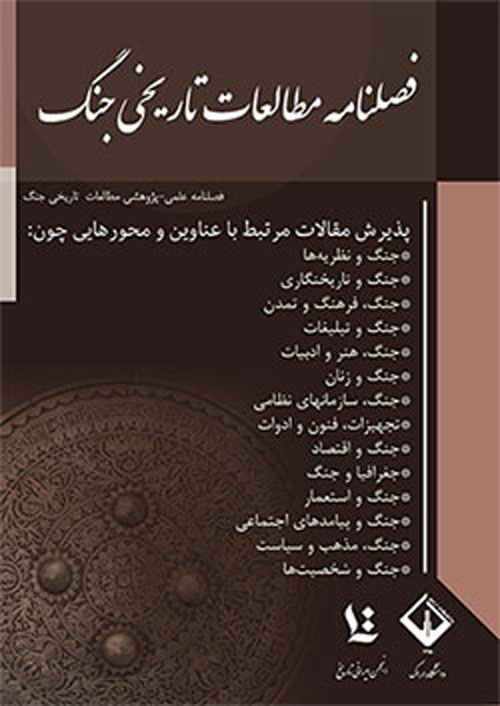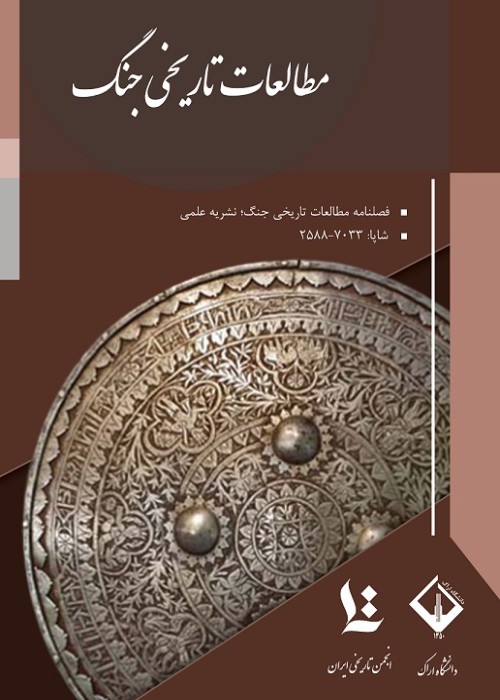فهرست مطالب

نشریه مطالعات تاریخی جنگ
سال یکم شماره 1 (پاییز 1395)
- تاریخ انتشار: 1395/09/30
- تعداد عناوین: 5
-
-
صفحات 1-18غزوه بدر نخستین جنگ مهم پیامبر اسلام (ص) بود که پیروزی در آن بر حیثیت و جایگاه مسلمین و حکومت نوپای مدینه افزود. این جنگ به دلیل اهمیتی که داشت، هم مورد توجه خداوند متعال در قرآن کریم قرار گرفت و سوره انفال در شان آن نازل شد؛ و هم سیره نویسان و اخباریان اسلامی بدان توجه ویژه ای داشته اند؛ اما ظاهرا نگاه قرآن با سیره نویسان و مورخان بدان واقعه، اندکی متفاوت است. مسئله اصلی پژوهش، دستیابی به دلایل وقوع جنگ بدر از نگاه قرآن و تفاسیر اسلامی است. از این رو، این پرسش را مطرح می کند که چرا برداشت ها درباره این جنگ بین قرآن و سیره نویسان متفاوت است؟ و چرا سیره نویسان تلاش می کنند دیدگاه خود را بر قرآن تحمیل نمایند؟ فرض پیش رو در این نوشتار براین مبنا شکل می گیرد که قرآن عامل اصلی جنگ را دفع تهدید قریش علیه دولت نوپای مدینه می داند؛ اما سیره نویسان و مورخان، دلیل اصلی جنگ را حمله مسلمین به کاروان قریش و دستیابی به منابع مالی آنها ذکر می کنند. دستاورد پژوهش بررسی و تجزیه و تحلیل نبرد بدر با رویکرد قرآنی و متفاوت از نوشته سیره نویسان اسلامی است.کلیدواژگان: قرآن، سیره نویسان، غزوه بدر، کاروان قریش
-
صفحات 19-44ایام العرب ها به عنوان بخشی از تاریخ عرب، همواره مورد توجه مورخان تاریخ اسلام و عرب قرار داشته و بخشی از مطالعات آنان را تشکیل داده است؛ اما در این میان توجه اصلی این مورخان بر جنبه های ادبی و بلاغی آن بوده و کمتر به بررسی مقوله و مفهوم جنگ نزد قبایل عرب بیابان گرد پرداخته اند. این در حالی است که با بررسی شرایط جغرافیایی و نظام قبیله ای موجود در شبه جزیره عربستان پیش از اسلام، جنگ به عنوان واقعیتی انکارناپذیر از حیات اجتماعی عرب تلقی می گردیده است. با توجه به خلاء پژوهشی موجود در این زمینه، این پژوهش بر آن است تا با بررسی زمینه های جامعه شناسی ایام العرب ها، مسئله جنگ را نزد اعراب (عرب بادیه نشین) پیش از اسلام موردپژوهش قرار دهد. فرضیه این پژوهش آن است که به نظر می رسد اعراب، فراسوی نگاه اقتصادی به جنگ، جهت تامین معیشت خود، آمال دیگری را در آن جستجو می کردند. آنان جنگ را نه تنها نوعی راهزنی و دزدی به حساب نمی آوردند، آن را همچون ورزشی محبوب که در آن قهرمانان قبیله از جایگاه والایی برخوردار بودند می نگریستند؛ ضمن آن که برتری طلبی، کسب افتخار و شرافت، شجاعت، جوانمردی و در نهایت سعادت خود را در آن جستجو می کردند.کلیدواژگان: عربستان، اعراب، جاهليت، ايام العرب، جنگ
-
صفحات 45-72جنگ جهانی اول برای ایران پیامدهای زیانبار بسیاری از جمله مثلث سیاه قحطی، ناامنی و بیماری در پی داشت که بخشی از پیامدهای این جنگ در کشور ایران بود. این پژوهش با استناد به منابع از جمله خاطرات برجای مانده و روزنامه های منتشر شده در همان زمان در شهر اصفهان، تلاش دارد ابعادی از این فاجعه انسانی را در این شهر به تصویر کشیده و نشان دهد مصائب قحطی، ناامنی و بیماری چه اثراتی بر شهر برجای نهادند؟ مدیریت شهری در این میان چگونه عمل می کرد؟ و تصمیمات نهادهای مختلف شهری از جمله حاکم و بلدیه چقدر بر معادلات فوق اثر نهادند؟ یافته های پژوهش که با شیوه تاریخی است نشان می دهد که بروز عوامل مختلف از جمله ناامنی، قحطی و شیوع بیماری، روزگار سختی را برای مردم اصفهان پس از جنگ جهانی اول برجای نهاده بود و نحوه مواجهه مدیریت شهری، متنفذان، مردم و جوانان را با این پدیده ها و تبعات آن نشان می دهد.کلیدواژگان: جنگ جهانی اول، اصفهان، ناامنی، قحطی، بیماری
-
صفحات 73-93مساله پژوهش حاضر بررسی پیامدهای جنگ جهانی دوم بر مناطق ساحلی و پس کرانه ای خلیج فارس است و فرض بر این است که آن جنگ پیامدهای منفی زیادی از جمله گسترش تشتت سیاسی و کاهش محسوس میزان تجارت و روابط تجاری ایران با سایر مناطق، بنادر و کانون های تجاری جهانی و در نتیجه رکود اقتصادی و افت تجارت خارجی ایران در خلیج فارس داشته است.
خلیج فارس به عنوان مهم ترین شاهراه اقتصادی ایران در آن مقطع تاریخی، تاثیرات زیادی در تحولات سیاسی، اقتصادی واجتماعی ایران داشت و هرگونه تغییری در کرانه ها و مناطق پس کرانه ای آن موجب تاثیرگذاری بر سایر مناطق و حتی مرکز ایران می شد. این مقاله برآن است با استناد به منابع و اسناد معتبر تاریخی پیامدهای این رویداد بزرگ تاریخی را در مناطق کرانه ای و پس کرانه ای خلیج فارس مورد بررسی قرار دهد.کلیدواژگان: مناطق کرانه ای، مناطق پس کرانه ای، تشتت سیاسی، کانون های اقتصادی -
صفحات 95-113سقوط حکومت صفویه به سال 1135ق. ق به واسطه شورشی در شرق کشور، محصول علل و عوامل چندی است که یکی از آنها به عملکرد نظامی حکومت صفوی در قبال شورش افاغنه برمی گردد. هرچند دولت صفوی طی سال های1120 تا1135ق. اقدامات قابل توجهی در عرصه نظامی برای مقابله با شورش افاغنه به عمل آورد، اما توفیقی حاصل نکرد. پاسخ به چرایی ناکامی در حوزه نظامی و تحلیل عوامل خنثی کننده یا کم اثرکننده مدیریتی، اجتماعی و سیاسی این اقدامات، مهم ترین دغدغه های این پژوهش است. برای یافتن علل و عوامل حقیقی بروز چنین شرایطی، اقدامات نظامی انجام شده در مهار این بحران و موانع و کاستی ها و نارسایی های موجود بررسی گردید. در مجموع عواملی چون غفلت ها، سستی ها، وقت کشی ها، سوء مدیریت نیروها و عوامل مرکزی، ضعف فرماندهی و ضعف اطلاعاتی و نبود انگیزه مقاومت و جنگ، شورشیان افغان را پیروز نهایی این کشاکش ها قرارداد. البته نقش عوامل ساختاری، اجتماعی، سیاسی و مدیریتی دوره سلاطین پیشین که به طور مستقیم و غیرمستقیم نیروی نظامی را تضعیف می کرد، غیرقابل انکار است. روش این پژوهش روش گردآوری اطلاعات، ارزیابی داده ها و تجزیه و تحلیل آنها، به شیوه تبیین تاریخی است.کلیدواژگان: شورش افاغنه، سلطان حسین، نیروهای نظامی، عوامل مدیریتی، شکست های نظامی
-
Pages 1-18The Battle of Badr was the holy Prophet's first important battle (SWA) the victory in which improved the reputation and the position of Muslims and their nascent state in Medina. Because of its significance, this battle is specifically mentioned in the holy Quran, in the Surah al-Anfal, the very revelation and completion of which was for and after this battle. In addition, Islamic biographers and narrators have paid a special attention to this battle although their opinions are apparently somehow different from the Quranic view. Finding the real causes of the Battle of Badr based on the Quran and Islamic exegeses was the main concern and question of the present research. Thus, this question was raised that why the interpretations about this battle vary from the Quranic view to that expressed by the biographers of the Prophet and why the latter try to impose their perspective on the Quran. It is hypothesized that the Quran sees thwarting the Quraysh's threat as the real cause of this battle while biographers of the Prophet and historians point to the attack of Muslims on the Quraysh caravan for acquiring their assets as the main motivation. What this study achieved is a review and analysis of the Battle of Badr from a Quranic perspective, different from the writings of the Islamic biographers.Keywords: the Quran, biographers of the Prophet, the Battle of Badr, the Quraysh caravan
-
Pages 19-44As part of Arabs history, Ayyām al-ʿArab has always been a focus of attention for the historians studying the history of Islam and Arabs. However, their main concern has been literary and rhetorical aspects and they have been less concerned with the concept and phenomenon of battles among the nomad Arab tribes. This is while against the backdrop of geographical conditions and the dominant Pre-Islamic tribal system of Arabian Peninsula, battles were perceived as an integral reality of the Arabs social life. Studying the sociological contexts of Pre-Islamic battles, known as Ayyām al-ʿArab, and aiming at filling the existing research gap, this paper attempted to study the issue of warfare as Pre-Islamic Arabs perceived it. The hypothesis of this study is that it seems Arabs, beyond having an economic view of warfare, to secure their livelihoods, sought other purposes in battles. They considered warfare not as a form of banditry but as a popular sport in which the tribe's heroes enjoyed high positions. In addition, they sought hegemony, honor and dignity, courage, chivalry and eventually their salvation in it.Keywords: Arabian Peninsula, Arabs, jahiliyyah, Ayy?m al ?Arab, warfare
-
Pages 45-72World War I (WWI) had many destructive consequences including the black triangle of famine, insecurity and disease spread, part of which occurred in Iran. The present article, based on resources inclusive of diaries and newspapers, published in that period in Isfahan, is an attempt to depict only dimensions of that human catastrophe and to show the effects of famine, insecurity and diseases on the city, what the civil authorities did at that time and to what extent the decisions made by them including the governor and the Baladia (municipality) influenced the circumstances. The findings of this historical study show that following WWI, Isfahan's people were inflicted with a hard and painful life due to causes such as insecurity, famine and disease outbreak. It also shows how civil authorities, influential figures, people, and the youth encountered these phenomena and their aftermath.Keywords: Isfahan, World War I, insecurity, famine, disease
-
Pages 73-93The present article aimed at analyzing World War II's consequences on Iranian coastal areas and the surrounding regions. It is hypothesized that this war has had numerous negative impacts such as the spread of political divisions and the reduction in Iran's trade level and commercial relations with the world's trade regions and centers and as a result the appearance of economic depression and a downfall in the country's foreign trade in the Persian Gulf, which as the Iranian most important economic trade route at that historical point in time had numerous effects on Iran's political, economic and social developments and any changes in the coastal areas and the surrounding regions influenced other, even the country's central, regions. In short, WWII had a direct impact on political, economic and even social life of the Persian Gulf and its surrounding areas and brought about different consequences. Therefore, drawing on reliable historical resources and documents, this study sought to investigate the consequences of WWII, as an important historical event, for the Persian Gulf's coastal areas and hinterlands.Keywords: coastal areas, hinterlands, political divisions, economic centers
-
Pages 95-113The application of biological factors or in its modern sense biological weapons in order to eliminate and defeat enemies and adversary groups, as well as obtaining more benefits, has been one of the biggest human concerns in warfare especially in the recent decades. The use of biological factors as a weapon to reach different military-political goals has also been seen in the history of political development of Islamic middle ages. Thus, the present historical-explication stud attempted to answer this principal question that what status and function the biological factors had in the field of military developments in the middle ages of Irans history. The findings indicate that biological weapons have had the potential to change the military power balance and affect the defeats and victories besides having a propagandic impact and thus demoralizing enemies. In this regard, damaging enemie's weapons and equipment by means of biological factors and the elimination of prominent figures is another influence area of biological weapons in the military and political fields, of which hundreds of examples were recorded in the middle ages of Irans history.Keywords: biological factors, microbiological weapons, military functions, Islamic middle ages, Iran's history


